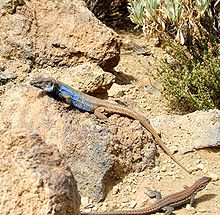| Gallotia Temporal range: Miocene–Recent
| |
|---|---|

| |
| Tenerife lizard (Gallotia galloti galloti) male (top) and female | |
| Scientific classification | |
| Domain: | Eukaryota |
| Kingdom: | Animalia |
| Phylum: | Chordata |
| Class: | Reptilia |
| Order: | Squamata |
| Family: | Lacertidae |
| Subfamily: | Gallotiinae |
| Genus: | Gallotia Boulenger, 1916 |
| Species | |
The genus Gallotia are the lacertids (wall lizards) of the Canary Islands. This genus consists of a group that has been evolving there ever since the first islands emerged from the sea over 20 million years ago. The endemic species and subspecies of this group have a number of characteristics that make them quite special within their family (Lacertidae); their only close relatives are the sandrunner lizards (Psammodromus) of the western Mediterranean region. Gallotia are characteristic for eating significant quantities of plants, and several lineages are often presented as classic examples for insular gigantism. However, a find of an even larger Gallotia species from the early Miocene of mainland Europe casts doubt on this assumption. Instead the ancestor of all modern Gallotia species of the Canary islands was probably already very large but carnivorous (Černaňský et al., 2016).